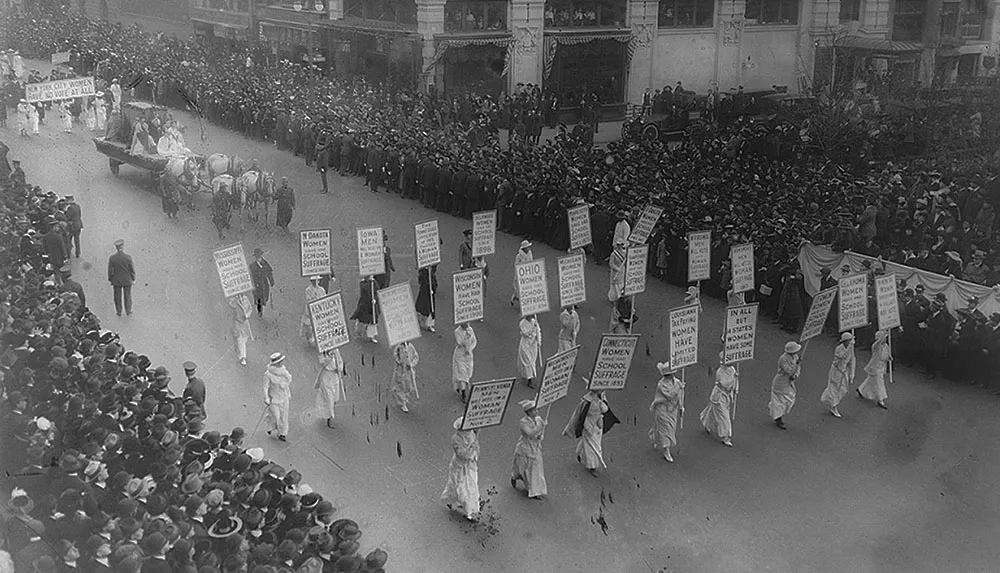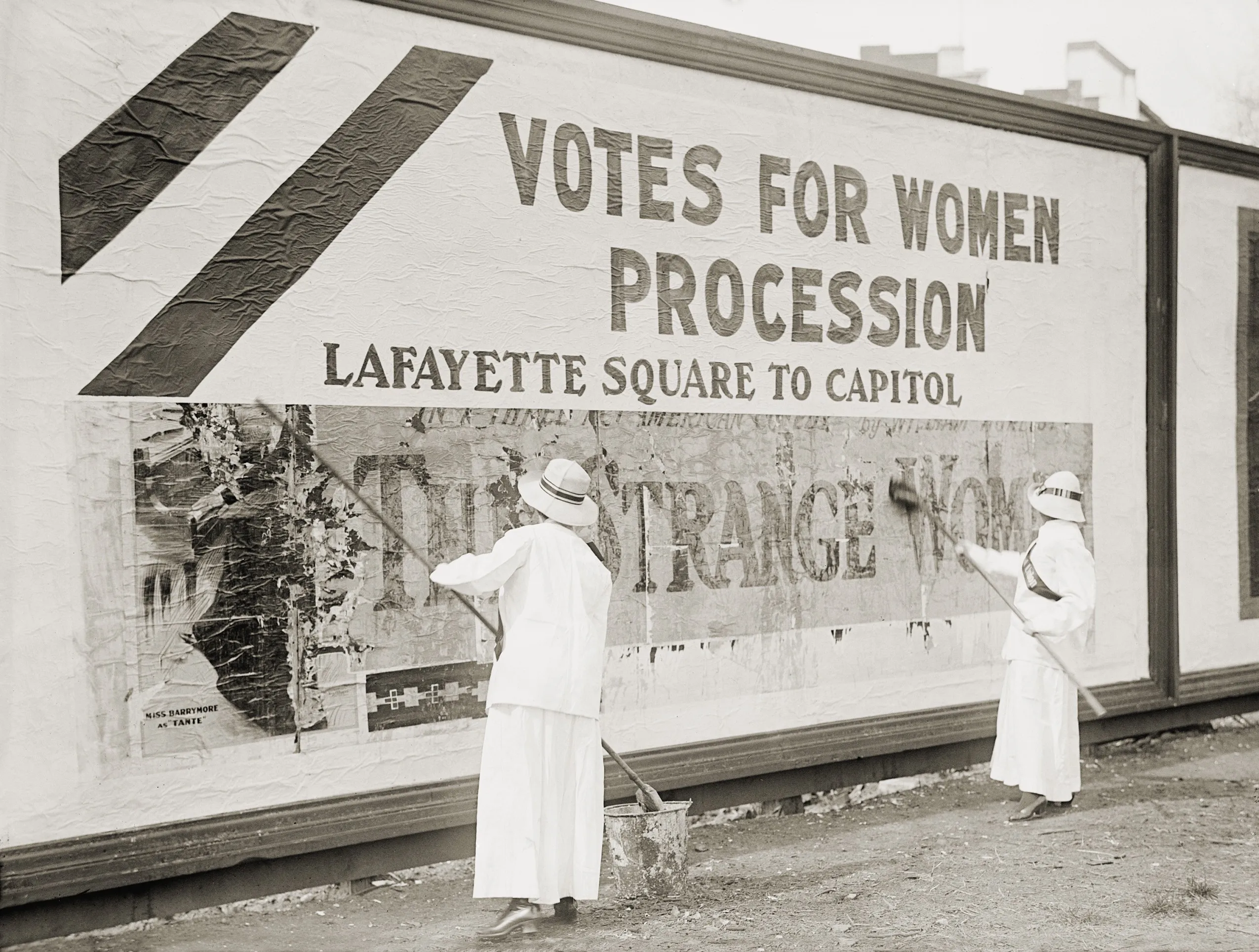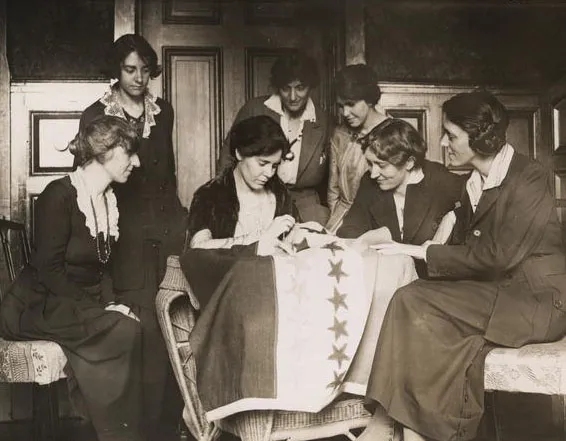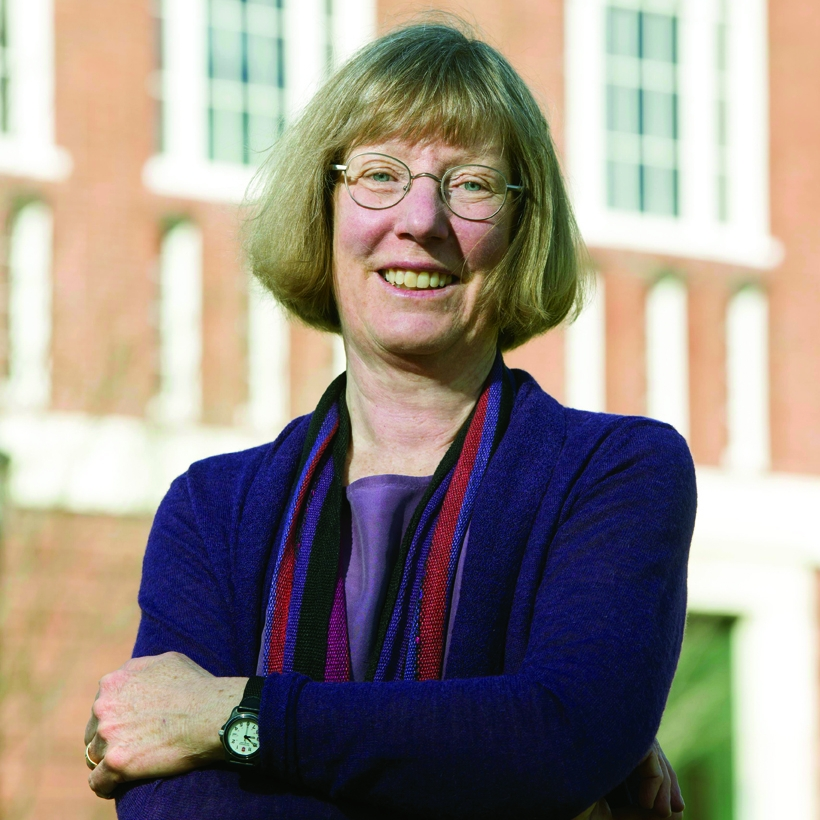
Leaving all to younger hands
The campaign to win passage of the 19th Amendment guaranteeing women the right to vote stands as one of the most significant and wide-ranging moments of political mobilization in all of American history. Among other outcomes, it produced the largest one-time increase in voters ever. As important as the goal of suffrage was, the struggle was always far broader than just the franchise, and it spoke to fundamental questions about women’s roles in politics and modern life: Who does the government permit to vote? What is the relationship between citizenship and suffrage? The suffragists challenged the political status quo at the time and in many ways can be thought of as the voting rights activists of their day. That observation is still true today as women approach their second century of full voting rights and leads us to explore why does the history of women’s suffrage matter?
The women’s suffrage movement always had a deep sense of its own history. In many ways, suffragists were our first women’s historians, none more so than Susan B. Anthony. When the fourth volume of the History of Woman Suffrage appeared in 1902, the 82-year-old Anthony looked back with pride at what the movement had accomplished, but she also looked forward to what still needed to be done, penning this inscription in her friend Caroline Healey Dall’s personal copy:
This closes the records of the 19th century of work done by and for women— what the 20th century will show—no one can foresee—but that it will be vastly more and better—we cannot fail to believe. But you & I have done the best we knew—and so must rest content—leaving all to younger hands. Your sincere friend and coworker, Susan B. Anthony.1
When she wrote those words, Anthony had devoted more than 50 years to the women’s suffrage movement and victory was nowhere in sight. Yet she remained proud of what she and her co-workers had done for the cause, and confident that the future would bring even more progress. I suspect that the suffrage leaders who guided the movement to its successful conclusion on August 26, 1920, felt the same way.
Once the 19th Amendment passed, suffragists claimed a new moniker—that of women citizens.
“Shall Not Be Denied”
The 19th Amendment states that “the right of citizens to vote shall not be denied or abridged by the United States or by any State on account of sex.” The amendment was originally introduced in Congress in 1878 but it took until 1919 before it enjoyed sufficient bipartisan support to pass the House of Representatives and the Senate. Then it needed to be ratified by the legislatures in three-fourths of the states. By March 1920, 35 states had ratified the amendment, but that left suffragists one short. In August, Tennessee put the amendment over the top, paving the way for women to vote in the 1920 presidential election.
Suffragists-turned-women-citizens
Once the 19th Amendment passed, suffragists claimed a new moniker—that of women citizens. In many ways the suffrage movement was an anomaly, the rare time when a broad coalition of women came together under one banner. In the post-suffrage era, politically engaged women embraced a wide variety of causes rather than remaining united around a single goal. Their political ideologies ran the gamut from progressive to moderate to conservative, but when it came to politics and public life, their message was clear: “We have come to stay.”
In this enlarged perspective, the suffrage victory is not a hard stop but part of a continuum of women’s political mobilization stretching not just between the iconic Seneca Falls Convention of 1848 and the passage of the 19th Amendment in 1920 but across all of American history. It is still appropriate, indeed welcome, to commemorate the centennial of the 19th Amendment as an important marker in American women’s history. But, rather than positioning 1920 as the end of the story, it is far more fruitful to see it as initiating the next stage in the history of women’s political activism—a story that is still unfolding.
Throughout American history, women have been dedicated political actors even without the vote. Women’s political history is far broader than the ratification of a single constitutional amendment.
Passage of the 19th Amendment: An incomplete victory
When thinking about the larger implications of the suffrage victory, we also need to remember that many women, especially those in Western states, were already voting in the years before the passage of the 19th Amendment. In addition, many women across the country enjoyed the right to vote on the local level in municipal elections and for school committees. Focusing too much on the 1920 milestone downplays the political clout that enfranchised women already exercised, as well as tends to overshadow women’s earlier roles as community builders, organization founders, and influence wielders. Throughout American history, women have been dedicated political actors even without the vote. Women’s political history is far broader than the ratification of a single constitutional amendment.
Celebrating the passage of the 19th Amendment also slights the plight of African American voters, for whom the 19th Amendment was at most a hollow victory. In 1920, the vast majority of African Americans still lived in the South, where their voting rights were effectively eliminated by devices such as whites-only primaries, poll taxes, and literacy tests. For Black Americans, it was the Voting Rights Act of 1965, not the 14th, 15th, or 19th Amendments, that finally removed the structural barriers to voting.
In a parallel disfranchisement, few Native American women gained the vote through the 19th Amendment. Not until 1924 did Congress pass legislation declaring that all Native Americans born in the United States were citizens, which cleared the way for tribal women to vote. But Native American women still faced ongoing barriers to voting on the state and local levels, especially in the West, as did Mexican Americans. Puerto Rican women did not gain the vote until 1935 and Chinese American women not until 1943. When assessing who can exercise the right to vote, it is always essential to ask who cannot.

Suffrage and feminism
Women’s demand for fair and equitable treatment in the political realm emerges as an integral part of the history of feminism. To protest women’s exclusion from voting demanded an assault on attitudes and ideologies that treated women as second-class citizens; to formulate that challenge involved conceptualizing women as a group whose collective situation needed to be addressed. Unfortunately, white suffragists often failed to realize they were speaking primarily from their own privileged class and race positions. The fact that certain groups of women, especially women of color, were often excluded from this supposedly universal vision demonstrates how racism intersected with feminism throughout the suffrage movement and its aftermath. Contemporary feminists have significantly broadened their commitment to recognizing the diversity of women’s experiences and worked hard to include multiple perspectives within the broader feminist framework, but it is still a struggle. The suffrage movement is part of that story, warts and all.
A global struggle
The history of women’s suffrage also reminds us that the struggle for the vote was a global phenomenon. Starting in the 1830s and 1840s, American and British abolitionists forged connections that influenced the early history of the suffrage movement. Elizabeth Cady Stanton and Lucretia Mott first met at an antislavery conference in London in 1840. Women’s international networks were especially vibrant in the late 19th and early 20th centuries. In 1888, the International Council of Women was founded to bring together existing women’s groups, primarily from North America and western Europe, with Elizabeth Cady Stanton and Susan B. Anthony as its prime instigators. Its offshoot, the International Woman Suffrage Alliance, founded in Berlin in 1904 “to secure the enfranchisement of the women of all nations,” fed the growth of the women’s suffrage movement worldwide. Women today enjoy nearly universal access to the franchise, but it is a misnomer to say that women were “given” the vote. Just as in the United States, women around the globe had to fight for that right.
Empowered through solidarity
Participating in the suffrage campaign provided women with the kind of exhilaration and camaraderie often described by men in periods of war or political upheaval. Women were proud to be part of this great crusade, and they cherished the solidarity it engendered for the rest of their lives. Frances Perkins, a veteran of the New York suffrage campaign and the first woman to serve in the cabinet as Franklin D. Roosevelt’s secretary of labor, remembered it this way: “The friendships that were formed among women who were in the suffrage movement have been the most lasting and enduring friendships—solid, substantial, loyal—that I have ever seen anywhere. The women learned to like each other in that suffrage movement.”2

Factions within the movement
The history of women’s suffrage also confirms the difficulty of maintaining unity in social movements. Women’s rights and abolition were closely allied before the Civil War, but that old coalition linking race and gender split irrevocably in the 1860s. The dispute was about who had priority: newly freed African American men or white women, who also wanted to be included in the post-Civil War expansion of political liberties represented by the 14th and 15th Amendments. Suffragists such as Lucy Stone, Henry Blackwell, and Julia Ward Howe had hoped for universal suffrage, but once the amendments were drafted, they supported ratification despite the exclusion of women. Susan B. Anthony and Elizabeth Cady Stanton adamantly refused to support the amendments, often employing racist language to imply that white women were just as deserving of the vote as African American men, if not more so. By 1869 the suffrage movement had split in two over this question, not to reunite until 1890.
That split was both strategic and philosophical, as was the one in the 1910s between Carrie Chapman Catt’s mainstream National American Woman Suffrage Association (NAWSA) and Alice Paul’s upstart National Woman’s Party (NWP). Catt’s much larger group tended to favor a state-by-state approach, while Paul and her supporters focused on winning a federal amendment. In addition, NAWSA was committed to working within the system while the NWP took to the streets, silently picketing the White House to express their outrage at women’s voteless status. In the end both sides were necessary to win ratification, just as the 19th century split had allowed competing personalities with different approaches to advance the movement in their own ways.
It is a misnomer to say that women were “given” the vote. Just as in the United States, women around the globe had to fight for that right.
Toward the future of equality in practice as well as in law
By the early 20th century, women had already moved far beyond the domestic sphere and boldly entered public life, yet a fundamental responsibility and privilege of citizenship—the right to vote—was arbitrarily denied to half the population. The 19th Amendment changed that increasingly untenable situation, representing a breakthrough for American women as well as a major step forward for American democracy. The wave of female candidates in the 2018 midterm elections and the unprecedented number of women who ran for president in 2020 built directly on the demands for fair and equitable access to the political realm articulated by the women’s suffrage movement.
Historian Anne Firor Scott provides an especially evocative image of how winning the vote was part of larger changes in women’s lives and in American society more broadly: “Suffrage was a tributary flowing into the rich and turbulent river of American social development. That river is enriched by the waters of each tributary, but with the passage of time it becomes increasingly difficult to distinguish the special contributions of any one of the tributaries.”3 Think of the contributions of the hundreds of thousands of rank-and-file women who participated in the fight to win the vote as the tributaries that make up suffrage history. And then think of suffrage history as a powerful strand in the larger stream of American history, which is richer and stronger because it heeded Elizabeth Cady Stanton’s prescient statement at Seneca Falls that all men and women are created equal. While the United States still lacks truly universal suffrage and gender equity remains a widely debated issue, the 19th Amendment represented a giant step toward both goals and left a firm constitutional foundation for future progress. When Susan B. Anthony talked about “leaving all to younger hands,” I like to think this is what she had in mind.
- This inscribed volume is found in the collections of the Schlesinger Library, Radcliffe Institute for Advanced Study, Harvard University.
- Susan Ware, Why They Marched: Untold Stories of the Women Who Fought for the Right to Vote (Cambridge: Belknap Press, 2019), p. 280.
- Anne Firor Scott, “Epilogue,” in Jean H. Baker, ed., Votes for Women: The Struggle for Suffrage Revisited (New York: Oxford University Press, 2002), p. 194.
As is the case of all Brookings publications, the conclusions and recommendations presented in this article are solely those of its authors and do not reflect the views of the Brookings Institution, its management, or its scholars.




